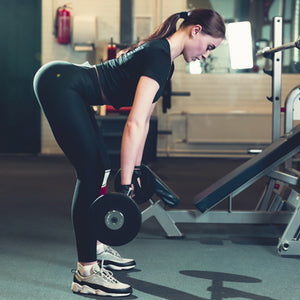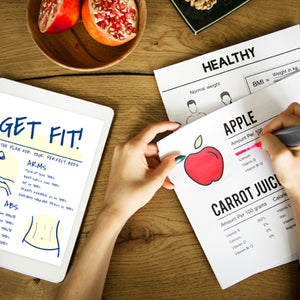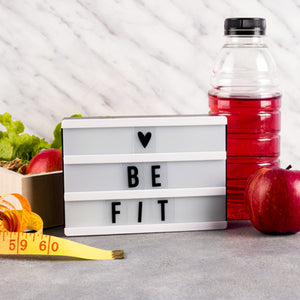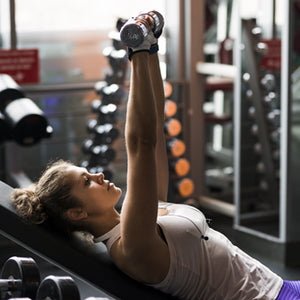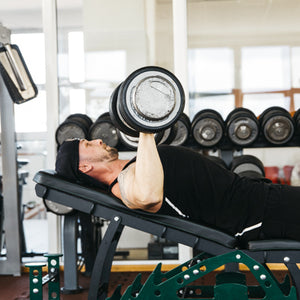
Delt Destruction: 10 Moves For Big, Broad Shoulders
Regardless if you're male or female, well-developed shoulders will make your waist look smaller and gives you that V-taper that presents an unarguable fact that you lift. Broad shoulders make your arms look bigger and your back look broader.
You could say shoulders are the hallmark of the ideal physique. In fact, the shoulder to waist ratio proportions of the classic physiques have been calculated at 1.618.
This presents a problem if your shoulder genetics are pathetic. But don't worry, we can make the most out of your genetic potential. If you've got a narrow frame and constantly find the shoulder seam of your t-shirt sinking down to your bicep, we're going to fix that.
Related: 5 Moves to Perfect Cannonball Delts
The first piece good news is that the delts are one of the simplest muscle groups to define, since the the region is on of the last areas to deposit fat. And, you don't have to accept the delts you've been delt.
You can build a great set of shoulders and get the size, shape and definition you've always wanted by training them properly. By incorporating these 10 moves into your training, you'll be hitting all three parts of the deltoids, setting you up for maximum gains.

Instead of looking into the mirror and witnessing a puny set of shoulders, you can now look forward to having big, broad shoulders that can't be ignored.
How to Get Big Shoulders
1. Cable reverse fly
The rear deltoid is often neglected, and thus that full round look of the shoulders is nowhere to be found. The rear delts are what make the shoulders pop. Direct work to the rear deltoids is imperative. That's why you'll see several movements dedicated to them on this list. The first of them being the cable reverse fly.
With all cable-based moves, the main benefit is the constant tension on the muscles being worked. Time under tension is crucial for hypertrophy, and with the cable reverse fly your rear delts don't' get a break until the set is ended.
Attach D-handles to the upper pulley of a cable machine. You'll take a cross handle grip and then straighten your arms without locking out your elbows (think about hugging on oak tree). To initiate the movement, you'll open your arms out to your sides, pulling each handle across your body. Be sure to make the mind body connection by using your rear delts to do the work.
When you've reached the point where your arms are open (creating a cross pose), return to starting position and repeat.
2. Seated dumbbell press
While the pressing motion is very similar when you're seated or standing, there is a difference between the two. Most notably, the assistance you can generate through your lower body and mid-section in a standing press allows for more weight to be moved.Seated presses are preferred when you want to isolate the delt, since the position doesn't allow you to recruit any assistance form your mid-section or lower body. Yes, you'll sacrifice some weight and reps in the seated dumbbell press, but it doesn't define it as better or worse. It's just more targeted.
Sit on a low back bench, holding a dumbbell in each hand above shoulder level. Be sure to take a grip that has your palms facing forward. Even though you're sitting, you'll want to make sure you're abs and back are engaged as you press the dumbbells in an arc above your head. To keep constant tension on the delt, stop short of lockout at the top and then lower the dumbbells to starting position and repeat.
3. Dumbbell Lateral Raise
To work the middle head of the delt, the dumbbell lateral raise is the old faithful. However, the movement often gets abused with too much weight and momentum from the hip swing makes this movement ineffective.In order to build out the middle part of your shoulders, you need to train them in a motion that requires your arms moving away from your body in a upward and out movement. This motion is impossible with a single barbell, but with two dumbbells it makes the perfect weapon for attacking the shoulders.
Hold the dumbbells at your sides with a neutral grip. You'll stand with feet shoulder width apart with your mid-line engaged and chest up. Without using any momentum, you'll raise the dumbbells out and away in a wide arc keeping your arms and elbows moving at the same rate. As both of your arms ascend and eventually reach the peak (about eye level), you'll want to think about your hand position.
At the top of the raise, it should look like you're pouring water out of a pitcher. Your thumbs should be pointed down. This places more emphasis on the middle delt.

Seated presses are preferred when you want to isolate the delt, since the position doesn't allow you to recruit any assistance form your mid-section or lower body.
4. Lying side lateral raise
Back in the golden era days, Arnold loved this exercise to bring up his delts. He hit these hard, often doing them until failure.This movement is a great alternative to standing rear delt raise because momentum is significantly reduced. The rear delt gets blasted in the lying side lateral raise.
Lie on one side on a slightly inclined bench, holding a dumbbell in your free hand. You'll start with the dumbbell hanging toward the floor with your arm across your body with a slightly bent elbow. To initiate, you'll use the rear delt to pull the dumbbell toward the ceiling until your arm is perpendicular to the floor. Lower the weight and repeat.
5. Push press
If you're obsessed with heavy compound movements, here you go. The push press can be utilized as a lead-off movement for a shoulder workout or as a finisher with higher reps making it a dynamic movement for shoulder development.You'll mainly be hitting the front and middle deltoids with the push press. But, the movement requires a lot more musculature than just the shoulders to perform properly. Your abs, back, and traps play a vital role in stability and movement efficacy. Your hips also provide the drive after the dip to provide power in moving the barbell overhead.
You'll start with a barbell in the racked position. Fore-arms should be perpendicular to the floor. Feet will be shoulder width apart. There are three ques to the push press: Dip, drive and press. On the dip, you'll maintain an upright chest with a solid rack position. Abs are turned on. The knees should track outward and your weight should be balanced across the mid-foot and heels. Dip about 1/5 of the way in comparison to front squat. From here you'll explosively perform the drive.
Your knees will extend first, then the hips will open up. Once the hips extend the press should initiate. You'll finish at the of the movement with the barbell overhead. Your back, abs, shoulders, traps, triceps will support the load. Lower to starting position and repeat.
6. Rope face pulls
For roaring rear delts, the rope face pull has little competition. The rope face pull incorporates leverage allowing you to handle more weight, while increasing overall time under tension. A sure-fire recipe for more muscle.You'll attach a rope to a seated row machine. Take a overhand grip so your palms are facing each other. To initiate, you'll pull the rope towards your face (right below your nose) while your elbows lift to about shoulder height. Squeeze the rear delts once you get to the top of the movement and then return to starting position without letting the weight stack to touch between reps.
7. Front plate raise
Even though you'll be using light weight here, don't be fooled. Front plate raises done at high reps will leaving you bent over pain, cringing at the face and looking for the nearest bench to sit down on and wonder what just happened.Hold a plate with both hands at the 3 and 9 o'clock positions. Your palms will be facing each other and your arms should be extended out in front of you (elbows shouldn't be fully locked out). Your arms will remain in this position for the whole set.
Raise the plate to slightly above eye level, hold for a one count and then descend to starting position. Don't let the plate rest on your hips at starting position. Good luck.

The push press can be utilized as a lead-off movement for a shoulder workout or as a finisher with higher reps making it a dynamic movement for shoulder development.
8. Bent press
The bent press is an old-time strongman movement. It's an impressive lift that builds upper-body, core, and leg strength. Plus it dramatically improves mobility. Adding the bent-press to your shoulder development will ensure that you're not all show and no go.You'll start with a kettlebell in racked position. While keeping your stance, you'll rotate your thoracic spine keeping the kettlebell racked. From here you'll simultaneously push your hips back, drop your upper body to the floor while pressing the bell over head. You continue this descend until your opposite hand touches the ground. To recover, you'll stand straight up while keeping the kettlebell in a full lockout position.
9. Wide grip upright row
The smith machine gets a bad wrap from people who don't know how to utilize properly. Yes, barbells and free weights are awesome. No, the smith machine shouldn't replace them. But that isn't grounds to quarantine the smith machine altogether.By utilizing the smith machine for the wide grip upright row, you take the stress of the lower back and shoulder joints since the bar is in a controlled range of motion and out in front of you. This also allows for a slightly better targeted movement for the delts. Upright rows are commonly known for hitting the middle delt, but by taking a wider grip, you can hit your traps and rear detls simultaneously. Here's how you do it:
Take an overhand grip (about 6 inches from your legs with each hand) with a shoulder width stance. Twist the bar to release it from the safety pins and let your arms hang. Then you'll initiate the movement by driving the elbows up and out bringing the bar towards your chin. At the top of the movement, your elbows will be slightly below your ears. Squeeze at the top and return to starting position to repeat.
10. Shoulder circles/press/lateral raise
This is a brutal finisher for any level of lifter, it'll also improve mobility.Take a light weight (10-15 pounds) and find a bench to sit on. Take your dumbbells and extend them out with your palms down. Keep a slight bend in the elbow. Keeping this arm position, make 10 circles with each dumbbell. These don't have to be huge circles, circles about the size of a basketball will work. Once you do 10, reverse direction and do 10 more.
Drop your light dumbbells and then pick up another set of dumbbells at a moderate load (this will be relative to the lifter, but somewhere between 20-50 pounds). Perform 10 seated dumbbells presses.
Drop the dumbbells. Pick up a pair of light dumbbells and perform 15-20 lateral raises to finish off this tri-set.
Broad Shoulders Wrap Up
Instead of looking into the mirror and witnessing a puny set of shoulders, you can now look forward to having big, broad shoulders that can't be ignored. You have no problem wearing a cut off at the gym, and the shoulder seams of your t-shirt now sit where they belong rather than dropping down your bicep.All because you've done the work. And more importantly, you've denied to accept the delts you've dealt. You've taken matters into your own hands and build a pair of boulder shoulders. Good work my friend...good work.

